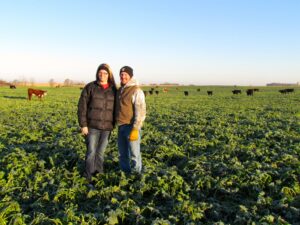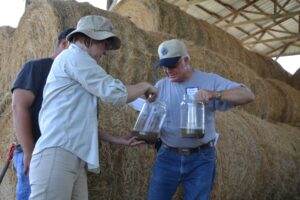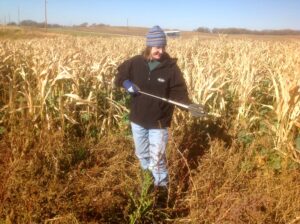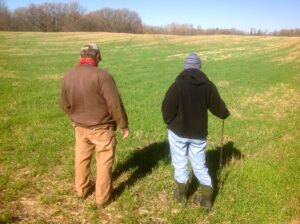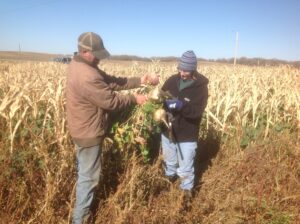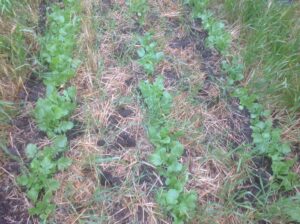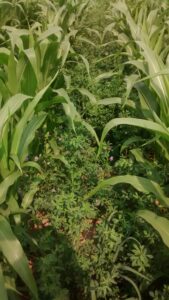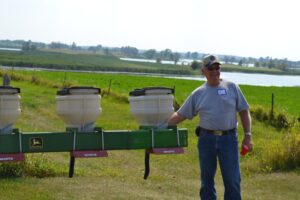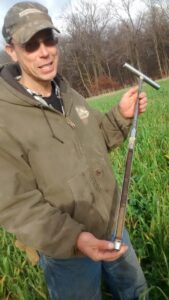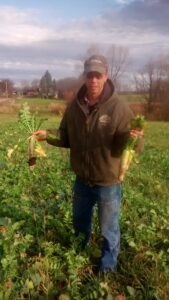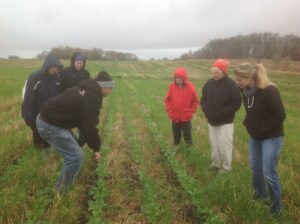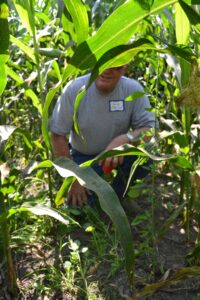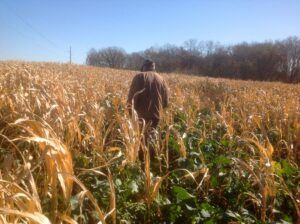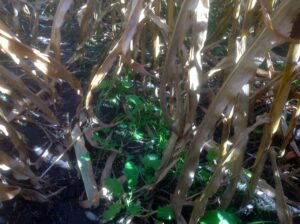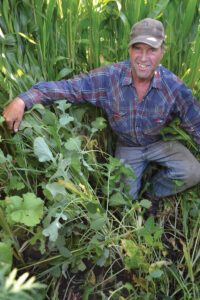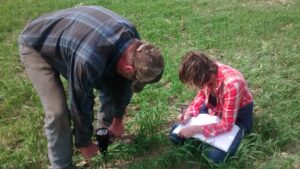Final Report for FNC14-964
Project Information
PROJECT BACKGROUND
The following farmers participated in this grant:
Taylor Morical, Jerry Morical: Taylor and his grandfather Jerry work 850 acres and raise commodity crops and beef cattle. They plant corn, beans, and small grains.
Daniel Jenniges: Daniel farms between 1500 and 1700 acres of row crops, hay, and pasture. He also has cattle -- between 200-300 depending on the year -- which he grazes on pasture and corn stalks. He raises corn, mostly for silage, beans, and small grains.
Jess Berge: Jess owns 400 acres and rents 200 acres, and grazes different parcels of public land with approximately 85 stock cows and 300 ewes. He has about 350 acres of row crop and approximately 500 acres of pasture that he manages annually.
John Ledermann: John farms about 1000 acres in corn, beans and wheat. He does not own any livestock.
Randy Mitteness: Randy farms 650 acres and runs a herd of 80 cows, finishing about 30 steers annually. He grows corn, soybeans, and wheat. He has seeded a turnip/wheatgrass mix into harvested wheat in the past to extend his late fall forage.
Jim Wulf: Jim grazes 200 head of cattle and would like to see his small grain cropland turned into better forage with appropriate cover crop mixes planted after small grain harvest.
Tyler Carlson: Tyler operates approximately 200 acres and has 25 head of cattle. Last year he seeded a cover-crop cocktail into a pasture that had very thin perennial cover due to poor soil. His goal was to build the soil quality and prepare the pasture to eventually become a mixture of perennial forage.
Mark Halls: Mark farms with his son and father, raising cattle, hogs, and row crops. He has been experimenting with cover crops to build his soil, to provide late fall/early winter forage for cattle, and to provide feed for wildlife to keep the deer pressure off his feed and hay.
PREVIOUS SUSTAINABLE PRACTICES
Taylor Morical, Jerry Morical: They transitioned to no-till on their entire acreage in 2012 and wanted to use cover crops to help with the predicted yield lag associated with that transition.
Daniel Jenniges: Dan has been planting cover crops after the harvest of irrigated food grade peas for 10 years and experimented with no-till.
Jess Berge: Jess has been interested in incorporating more cover crops and no-till practices on his farm and joined this group to accelerate that transition.
John Ledermann: John wants to transition all his acreage into no till and strip till and started strip tilling in 2012. He wants to reduce tillage and inputs.
Randy Mitteness: Randy had been transitioning his pastures into rotational grazing and joined this project to learn more about cover crops for grazing and to increase the soil health on his farm.
Jim Wulf: Jim was practicing rotational grazing and no-tilling beans before this project. He wanted to integrate more cover crops to increase grazing opportunities, reduce tillage, inputs, and increase soil organic matter.
Tyler Carlson: Tyler has been mob grazing and intensely managed rotational grazing since the establishment of his farm in 2011.
Mark Hall- Mark has been experimenting with cover crops for 8 years to build his soil, to provide late fall/early winter forage for cattle, and to provide feed for wildlife to keep the deer pressure off his feed and hay.
PROJECT DESCRIPTION
Although there has been a lot work around cover crops in the Midwest), this area of Minnesota has been slow to accept them. We need to change the regional conversation around cover crops, farming “norms”, and soil health. The best way to do that is support people in the region willing to experiment, to back up their experiments with consistent, annual soil testing and to effectively communicate that information to the larger regional farming community. This grant was written to provide support to committed work on figuring out how to make cover crops work with and without livestock in the Chippewa River Watershed.
Farmers in this group wanted to experiment with cover crops on a larger scale, learn about soil biology and biological testing, and to have field days to communicate what they learned to their neighbors and community. They wanted to see how the added expense and time associated with planting a cover crop payed in soil health, organic matter, late season forage, soil retention, and water management. The grant paid for cost share with cover crop seed, and paid farmers stipends for holding field days. This grant also paid for Haney soil testing that we reviewed as a group with an ARS (Agricultural Research Services) Soil Scientist. We had 2 field days and annual cover crop network meetings that were open to anyone interested in Haney testing or cover crops. The field days and meetings were organized by the Land Stewardship Project’s Chippewa 10% Project Coordinator, Robin Moore.
GOALS
- With cost share to reduce financial risk on cover crop experimentation, farmers will learn how to more effectively use cover crops with small grain, corn, soybeans, and in poor pasture land.
- By learning about soil biology and biological soil tests, participants will better understand how to build soil health, including organic matter and fertility, retaining and increasing available nutrients, reducing the costs of inputs and winter feed, creating sources of fall forage for grazing, keeping the ground covered after harvest, and retaining moisture in the summer.
- To increase community knowledge and understanding about cover crops, to increase local support and acceptance, and reduce local pressure to not be “different” with field days and involvement in NRCS tours.
- To develop and maintain a farmer network of people in the region who are experimenting and succeeding with cover crops, which will serve as a working resource for new people interested in support and also work to change regional beliefs that cover crops are not tenable in this area.
PROCESS
This project was based on a successful meeting held in 2012 where LSP invited anyone who had tried cover crops to come and talk about how it worked or didn’t work for them. The farmers who came expressed four things many times in the span of a couple of hours:
- Meeting and talking about the cover crops was extremely useful
- They wished they had some support to experiment with different seedings and mixes,
- They were all interested in more complex soil testing, and
- They all worried about what their neighbors were thinking.
That provided the structure for the grant.
Each farmer chose a cover crop scenario appropriate for their farm. One was trying to drill cover into poor pasture to try and increase forage as well as break up compaction and increase diversity. Two farmers without livestock were working on building soil, creating a better soil base for no-till farming, and reducing fertilizer and chemical inputs. The other 5 were focused on cover crops after small grains to provide late season forage and build soil health.
1) Mark Halls: In the first year of this grant, Mark planted 18 acres of cover crop after wheat harvest into a 4 species mix, primarily to see if it attracted wildlife and/or produced any value for forage. The wheat matured late that year and he found that he would really prefer to plant his cover crop earlier to make it valuable for cattle.
The deer continued to graze in that patch late winter and Mark was pleased with the fact that people stopped and asked about the field, feeling that he got a lot of good information to locals and neighbors about getting better cover and food plots for wildlife. He hopes to get the cover crop in earlier next year. Mark also hosted a field day in fall of 2014, called “Farmland Wildlife Food Plot Field Day” where the he described how he takes a proactive approach to keep deer out of his feed pile while keeping the ground covered, improving both soil health and water quality. Twenty-four people attended the field day and several people expressed interest in working with us to plant cover crop food plots next year. The workshop also sparked a conversation with the local DNR to put some cost share money into cover crop food plots as an effective method to protect local crops and feed stockpiles while feeding wildlife for more of the winter, relative to corn food plots.
In the 2015 growing year, Mark seeded a brassica/oats/wheat/forage pea mix after a small grain crop, which he grazed before knifing manure into it in November. He didn’t keep close numbers, but he felt that the field provided good forage for 2-3 weeks and that the extra growing roots late into the season helped maintain soil structure after knifing. There was more residue and some plants even kept growing, and he felt that the field was less vulnerable to erosion. He now follows most of his small grain harvest with a late season cover crop forage mix.
In the 2016 growing year, Mark planted a full season annual mix in some rented ground that needed more fertility and organic matter. He planted the mix, which included brassicas (rape, kale and turnips), grasses (oats and barley) and clover in early June. He grazed the piece 4 times with 30 pair for about a week each time. He was pleased with the regrowth and feels like the ground will be good for no-till corn next year. He intends to extend his corn/soy/small grain cover crop rotation to include a year of full season annuals to increase his available grazing ground, diversify his rotation, and build fertility, organic matter and soil health on more fields each year.
This year’s Haney test showed, compared with the knifed ground last year, with more cover, no ground broken with knifing, and living roots in the ground, that this field had better organic matter and biological activity than his previous tests. This meant that the N and P mineralization were higher, meaning more was available for the plants. He also had less inorganic N than in previous test, which reaffirms that the plants and soil biology are likely holding on to the N and cycling it, meaning it will be more available for the following year. The Carbon to Nitrogen ratio was also lower, which means that his organic N has gone up more than the C, which means the soil biology has enough N to break down carbon in the soil (residue, roots) and, again, means more N will be available for the 2017 growing year. Mark was pleased, and this final field soil analysis really helped him to understand how the nutrient cycling worked in different fields, with different practices and different covers. He said that this year really helps him put all his choices in perspective and understanding how the N cycles makes more sense now than before.
2) Jess Berge: In the 2014 growing season, Jess planned to plant cover crops following silage removal but, because of the cool wet summer, silage on this field didn’t get chopped until late September, and he wasn’t able to get a cover crop planted after flushing the ewes following the silage cutting. He did, however, try an experiment with a different field where he inter-seeded Italian ryegrass into an alfalfa pasture that was performing poorly. He drilled the grass in May and planned to harvest the rye grass after he had taken the first cut of alfalfa, anticipating that the alfalfa would continue to do poorly. What he found instead was that the rye germinated but did not produce much tonnage. The alfalfa however seemed to respond notably well to the increased diversity in the field and he got much more tonnage than in the previous years. In response to the difficulties with planting after silage, Jess has decided that planning to put in cover crop for grazing after silage chopping is a bad bet. He is going to increase his rotation to include more small grains and follow their harvest with cover crops for grazing. If he can plant any cover crops after silage, that would be a bonus, but he doesn’t believe it’s wise to plan on that for grazing.
In 2015 Jess planted a brassica mix after oats, allowing the oats to reseed as well. He purchased a seeding drill and was able to follow the combine with a drill. Even though it was a dry year, he felt that he had good growth on the field and was pleased with the cover. However, he felt that although the field looked lush, it did not feed his cattle for as long as he’d hoped. He was still glad to have the animals on the field, and knows that it was good for the soil, but he is unsure that the costs were less than the savings in feed.
In 2016, he used a full season annual mix on a 35-acre Wildlife Management Area that he rented from the US Fish and Wildlife service with the intention of fall grazing. He planted a brassica mix plus added oats in late May and found that, because of the early seeding, the tillage radish and turnips did very poorly, unlike previous years when he’d planted after July 15th and had better growth in different areas. He also felt that the soil in this area was dead and low fertility. He grazed 40 pairs on the field for about 6 weeks and overall felt that the rent and seed costs were not covered by the grazing.
His takeaway from this year was that, especially with a brassica mix, he needs to make sure there is enough fertility to support the annual crop. This may mean adding fertility (N) for the first season or two, but with continuous living cover, good residue, and by eliminating tillage, the applied nitrogen will not leach out and will continue to cycle and be available for crops in following years. His primary recommendation is that one fertilizes for a full season diverse annual mix just like one would for a regular commodity crop. He also recommends that you always add oats to a mix because they always germinate and makes the field look better faster “for the neighbors who think you might be crazy”.
Jess felt that the Haney test was a good entry point for learning a lot more about soil biology and health. We tested the same field for 3 years with 2 years of cover crops and grazing in the field. He found that the organic matter rose from 4.3% in 2014 to 5.8% in 2016, compared to a control adjacent field, with no cover crops or grazing, which did not rise at all. Also the soil health calculation rose slightly in the field with consistent cover, whereas the control field’s soil health calculation dropped. This helps him monitor the effects of his practices and he plans to continue the Haney testing, especially in the fields that he has already been monitoring.
3) Randy Mitteness: Randy had planned to put 27 acres into cover crop following wheat harvest. However, due to late wheat maturation, difficult harvest (the end of September), the wet weather and the need to spread manure on that field, the cover crop didn’t get planted in 2014. Randy has come to the same conclusion as Jess Berge, that he would rather plan to follow a small grain with cover for grazing than silage, as small grains have a more reliably early harvest. Randy also felt that his dependence on custom hire for the cover crop planting made it more difficult to get the cover crop planted in a timely manner. He purchased a drill for his own use to make sure that he could get cover crops in on his whole farm.
In 2015, Randy planted a cover crop on a 58-acre field following a wheat harvest with the intent of grazing. This ground was pretty rough ground, with low fertility and organic matter, and his region was suffering a drought. The crop germinated but didn’t mature enough to graze.
In 2016 he no-till planted the same field with a full season annual mix that he hayed in early August. Once again, regrowth was poor and it was not enough to graze although it kept living roots in the ground until winter. The soil on this field is so degraded that the Haney test did not show much improvement over 2 years. But a combination of education about soil biology and seeing the relative success on other farms with late season forage and soil organic matter increases leads Randy to think that including small grains and cover crops in his rotation will help to rehabilitate that land.
4) John Ledermann: In 2014, John planted 35 acres into a cover crop of white clover, tillage radish and Austrian field peas following wheat harvest. He used a drill to plant the peas and radish, and broadcast the clover over the planting. His goals for the cover crop was building soil structure, nutrient building, especially nitrogen, and weed suppression. John is using cover crops to help with his strip tilling operation and to reduce input usage and costs. The clover germinated well, but not in a consistent spread so he added a grass box to his drill. He also noted that where the clover germinated well, all the varieties of plants did better, where germination was sparse, the plants were smaller. John felt the clover did an especially good job at building soil structure and continued his experiments with both perennial clovers and annual covers for the entire 3 years.
After seeing how much better the peas and radish grew with the clover, John planted his clover at the same time as the wheat in 2015 and then after wheat harvest, which he reported as being good -- not above or below average. He then strip-tilled tillage radish and peas into the clover after wheat harvest. In 2016 he terminated the clover on that field and planted corn without any reductions in fertilizer. His harvests in this field were good, and he felt that the clover cover helped control weeds. John also experimented with crimson and red clover plantings with wheat, as well as planting some corn strips into white clover from the year before that he did not terminate. The crimson clover didn’t seem to grow with enough vigor to justify the seed cost, and the red clover seemed to grow with a little too much vigor, nearly swallowing up the wheat in the low spots.
Also in 2016, John planted red clover on April 6th with spring wheat. He harvested the wheat the 1st of August at about 70 bushels per acre. He thought this was very good since his yield goal was 60 b/a. On the 10th of August he used his planter to put a lentil/rape mix into that field. He found that the lentils did moderately well, but had a hard time competing with the vigor of the red clover along with the heavy reseeding of the spring wheat. The rape seemed to do fine. He was impressed with the overall biomass produced by the clover and the cover. It was a wet year and so the clover was very aggressive. He didn’t reduce his fertilizer inputs this year but plans to reduce nitrogen for following year’s corn crop. He will follow the same protocol, terminating the red clover just before strip-tilling corn into that field in 2017. He has found that clover, and then the cover crops after the wheat harvest, keep weed pressure down to a minimum.
John said that after looking at his soil tests, he was impressed with how much the soil improved. The overall soil health score went from a 15 to a 19. He also has learned that while his soil organic matters are rather low, with the living covers, his available N levels as well as his carbon to N ratios are very good. The clover fields have also shown increases in soil organic matter. John likes the Haney tests, but has a hard time accepting the fertilizer recommendations on the test. He feels that it’s very hard to gamble with a yield hit when he depends on that income, but it has made him feel more comfortable with slow and steady reductions over years. Each year he uses a little less and hasn’t seen a dip in yields so far. Finally, the years of familiarization with the Haney test along with Sharon, the soil scientist, has made him feel confident about signing up for the Haney test in the CSP payment program. He looks forward to learning more about the rest of his farm with these tests.
John highly recommends the clover/wheat seeding strategy. The slow establishment of the clover does not compete with the small grain, keeps the ground better covered, and makes sure there is no break in cover after harvest. He overall has preferred the red clover to the white clover. He also has found that he can reduce his nitrogen for corn the year following the wheat/clover year, and that, as stated before, he sprays less for weeds with the covers. He is not sure that anything but the radish and rape are good with the clover since the clover is so aggressive, but wants to keep experimenting with planting more late-season species into the clover. He also recommends bringing a group of farmers together to share information.
5) Taylor and Jerry Morical: In 2014, Taylor planted crimson clover on approximately 5 acres immediately before planting spring wheat on May 5th. He broadcast the clover and applied it at 5-10 pounds per acre. His goals were to provide weed control and to reduce nutrient and chemical inputs on the wheat. The weed suppression worked well and no in-season herbicide was needed. Through the season, the clover stayed below the canopy of the wheat and by harvest, it seemed to have died back a little and did not interfere with harvest in any way with the exception of one low spot that was very wet. In that area the clover outcompeted the wheat. Taylor did a soil test to compare the under-seeded, un-fertilized wheat with wheat NOT planted with clover that had received 10 gallons per acre of 28% N fertilizer, amounting to a difference of 30lbs per acre of Nitrogen fertilizer between the clover and the treated acres. The wheat receiving the top-dressing yielded 58 bushels per acre and the under-seeded wheat yielded 57 bushels per acre. The cost of the fertilizer and its application was $35 per acre. The cost of the clover seed and seeding totaled $20 per acre, resulting in a $15 per acre savings. One bushel of wheat was about $5.50 at harvest, resulting in a $9.50 per acre savings, which does not include herbicide and application savings.
In 2015 Taylor planted corn in this acreage and followed corn harvest with a winter rye/clover mix that he broadcast. The rye germinated well, the clover not as much. Taylor also planted a full season annual mix this year on a smaller parcel and rotationally grazed his cattle on the acreage all year in order to build soil organic matter. Taylor and Jerry experimented with hairy vetch inter-seeded with the corn, having read that vetch fixed high amounts of nitrogen and produced a large amount of biomass. The vetch did very well in the corn, maybe a little too well, as it made harvest very difficult, clogging up the combine. However, the cows loved grazing in the cornstalks and vetch. Taylor felt that the vetch was interesting and something he wanted to experiment more with in the future. Finally, the Moricals interseeded annual rye in much of their corn and it seemed to go very well.
In the fall of 2015 we held a field day at the Ledermann and Moricals featuring both full season annual diverse mixes for grazing as well as interseeding rye into standing corn. This field day included an NRCS rainfall demonstration with soils from the Morical’s farm. We had 32 people attend, many of them new to our organization. Both John and the Moricals were proud to show cover growing strong between their rows of corn, nearly ready to harvest. Both the Moricals and John have modified equipment to interseed rye and other covers into standing corn.
In the spring of 2016 the rye planted after the 2015 corn came well, Taylor grazed his small herd for a while, terminated the rye and clover with spray, and no-tilled beans into the stand. This eliminated a pass of herbicide and they were able to reduce their nitrogen application somewhat without seeing any yield lag. In 2016’s corn, the Moricals planted annual rye, rape and tillage radish when the corn was at 18 inches. This was a wet year and so they had a really good stand of cover after corn harvest. “The neighbors thought it looked pretty good”
Both Taylor and Jerry liked the Haney tests, and appreciated meeting with the ARS soil scientist to help make sense of the tests. They aren’t quite confident about the nutrient/fertilizer recommendations that the Haney test gives and would like to do some side by side comparison of corn with the Haney recommendations versus the standard recommendations. They also both valued the meetings with other farmers and hoped that the group would continue to share ideas.
The Moricals plan to continue to use cover crops. They found that helped a lot with transition to no-till farming and they feel like it protected them from yield lag, holds the soil, and they can see their organic matter is increasing. They feel it’s better for the long-view economics of their farm and the yields are fine, Jerry said “the green underneath the corn makes you smile”. Yields are right with everyone else in the area, and although they are in year 5 of no-till and cover crops, they haven’t started to reduce their fertilizer inputs significantly. They have reduced their need for herbicide.
Jerry feels that his personal next challenge is figuring out how to establish cover crop in soybeans. This fall they seeded a lot of cereal rye in the soybean ground after harvest and now that the snow is melting he can see the green and is hopeful that they can figure it out.
6) Tyler Carlson: In 2014, Tyler planted 6 acres of poorly performing pasture into an annual grazing mix. His goals were to provide good annual forage for finishing some grass fed beef, to break up the pasture’s compaction problem and to build soil fertility and structure. He thought that adding the diversity to the poor pasture could help build soil heath and improve production in the future. Tyler took a harvest of baleage off of the perennial stand in late May. He then used shallow chisel plow to set back the perennial stand, broadcast annual cover crop seed at 50 lbs an acre in early June, and then went back over again with a disc to cover seed. His cover crop mix included: Brown Midrib grazing corn, Brown Midrib sorghum sudan grass, pearl millet, Iron and Clay forage soybeans, turnips, Nitro radish, and oats.
The annuals performed well, and the perennial stand while set back, did not die. He strip-grazed the pasture and there was plenty of feed, although Tyler felt that he didn’t really have enough animals on it to properly graze the stand,. The steers were “cherry picking” and seemed to prefer the turnips and radish, grazing only about 20% of the stand total. He was able to graze the stand for 6 weeks, moving the cattle daily. He felt weed suppression was good, perhaps due to the sorghum, and also hopes that the sorghum and the radishes helped with the compaction issues. Next year he plans to drill annuals into this field, hopefully having loosened the hard pan and built enough tilth to have better germination without disturbing the soil again. He plans to treat the same pasture and hopes to see the difference over two years of annual cover crops in the poor pasture. His goals will be the same and, long term, he hopes to double or triple the production on this pasture by increasing soil nutrients and structure. He hopes to remain no-till from here on.
In 2015, Tyler grazed the pasture hard in the spring and drilled in a similar annual mix as the previous year around the first of June. This year, the annuals had a very weak establishment except for around the areas where he had done some bale feeding in the winter. He did not feel that the annuals produced any significant amount of feed and felt like the success around the bale feeding demonstrated that the annuals needed more fertility. It was a very dry year and it is also possible that the added organic matter around the bale feeding areas were able to hold onto more moisture for the establishing annuals.
In 2016 he did not seed any annuals, just managed the re-established perennials, and continued soil testing in the same areas. He overall preferred the Haney test to a standard Illinois test, and was surprised to find that the annuals didn’t seem to do anything to increase his soil health rating on the test. His control and treatment areas continued to test at similar levels for soil organic matter as well as the general soil health rating. He did see a slight growth in soil organic matter over the years and he attributes that to mob grazing. He got a lot of value from being able to go over the soil tests with a soil scientist and having several years of this support made him much more confident to invest on his own on biological testing. Tyler appreciated the cover crop network, but thinks that annual cover crops in an established perennial grass based system don’t have a lot of use. The main way they make sense for his operation is to seed them over and around winter feeding areas to capture the extra nutrients, provide a small amount of feed, and to break up compaction with deep roots in those areas. Otherwise, the benefits are far less than the biological and economical costs of tillage. In the future, he wants to try some other tests that more specifically map the biological community, like the PLFA test or other DNA tracking tests.
7) Dan Jenniges: In 2014 Dan put 12 acres that had been corn the previous year into a full season annual mix that included corn, soybeans, sugar beets, rape, kale, purple top turnips, Italian rye grass, oats, wheat, barley, red clover and cow peas. Dan’s goal for the crop was to see if he could build enough nutrients in that field with late season grazing on a diverse annual stand to avoid putting fertilizer on the field the following year. Dan drilled the mix in in mid-May, which is why he did not include tillage radish as they tend to bolt if planted too early. He reported that all the plants germinated and thrived with the exception of the sugar beets, which germinated but didn’t seem to grow. Dan was pleasantly surprised by the lack of weeds. Without any round-up or other herbicide, the field was almost completely clean except for the control strip where no cover crops were planted which was choked with weeds. We had early snow in November and then with the melt in mid-December, he didn’t graze the area until January, but the animals still ate the leaf/mush and all the tubers. After looking at the Haney test results, he felt confident that he didn’t have to add any amendments for the next year.
In 2015 Dan no-tilled corn into this field and it performed well. He also planted a similar mix of brassicas (kale, rape, turnip and tillage radishes), grasses (spring oats, barley, wheat, corn, BMR sorghum), and legumes (peas and soybeans) after an oat harvest. He grazed the field as of November and then fed winter rations over the field for the winter, moving the feeders every week. This field was recently rented to him with low fertility and organic matter. His goal with the covers and the grazing were to begin increasing both of those on this acreage. The Haney tests were not very conclusive the first year, but he wants to check the field again in a couple of years and since he has a base line and a much better understanding of soil health and biology, he is confident that he will see improvement on that field.
In 2016, in the same field he did a full season diverse annual crop in early May and hayed in once in late July. The annual mix only did moderately well after haying, with the brassicas and peas performing the best. He still grazed about 300 head on this acreage for 2-3 weeks. Dan had the PLFA on this field and found the field had excellent biodiversity, as compared to a control strip with just corn this year, although the overall biomass (total population of biology) was relatively low. Dan also had planted winter rye after corn in an adjacent hillside field, harvested it for hay in late June, and no-till planted a late season bean into the field. He had been frustrated with no-tilling into the intense root mass and the bean germination was not as full or even as he wanted, but then in the second week of July Dan got 7 inches of rain in one day. Fields around him had intense gully washing but his field stayed in place, and he was sure he would have lost much of that crop without the rye. He also ended up with good yield on that field. That experience has also interested many neighbors in planting rye after silage and corn harvest, also farming the local hills. Dan has found a local market and will be harvesting more rye for cover seed for himself and the surrounding community.
LSL article published on Dan Jenniges
Finally, Dan held a field day in December on winter grazing, where grazing cover crops planted after primary crop harvest and soil biology were part of the program. 43 people came to the event.
8) Jim Wulf: In 2014 Jim put 110 acres into a cover crop cocktail (he was unable to locate records of the exact mix for this report) following the harvest of an oats/peas mix on 40 acres and wheat on 70 acres. His goals for the cover crop were to improve soil fertility and structure, break up some compaction, and provide late season feed for some of his cattle. He had trouble getting the wheat off, as it had matured late and there was a lot of rain around harvest, so like the rest of the participants, the cover crop went in later than hoped, and consequently, he had less feed than he had hoped as well. Jim planted the cover crop by having it broadcast then working it lightly afterwards with a cultivator. He had some missed communication with the custom broadcasters who ran out of seed and he found out after cultivating that 35 acres still hadn’t been planted, so he broadcast the seed on top of those acres, which was followed by a heavy rain that night. He saw that the seed that was on top of the cultivated ground germinated much better than the seed that he had cultivated over, assuming that the latter seed had been buried too deep. Jim decided that he needs to invest in a drill to plant the seed more precisely and to be able to follow the combine with the drill, planting the cover crop as early as possible. He is also convinced that cover crops pay in feed and soil building even in a more difficult year like this one.
In 2015 Jim purchased his own drill and planted forage covers after all of his small grain, haylage, and silage crops. He continues to graze the acres and has started to experiment with winter rye for both spring grazing and for green manure and weed control. Jim opted out of this grant in 2015, feeling that he had quickly moved into large scale cover crop use as well as large scale soil testing and although the grant helped him affirm that cover crops and biological testing were worth his while, it was too small scale to continue to be useful.
PEOPLE
Robin Moore with the non-profit Land Stewardship Project in Montevideo, MN helped to coordinate the network and organize meetings, organized all of the associated field days, helped with soil sample collection, submitted all the soil samples, and managed the funds for this grant. She also helped farmers problem solve and connected them with resources when they had questions she was unequipped to help with.
Sharon Weyers of US Agricultural Research Services in Morris, MN helped with soil sample collection, she attended all field days and answered soil health and test questions, and was an integral part of our network meetings providing clarity and interpretation of the Haney tests for the farmers, both in the meetings and on one-to-one basis when the farmers wanted more help.
Jennifer Hoffman of the Chippewa River Watershed Project helped organize and advertise all field days. She also helped bring new people (not in this grant) to the cover crop network.
Jim Paulson of the U of M Extension service provided consulting resources on forage mixes for 2014 and 2015. He came to field days and answered questions, providing support for all participants.
RESULTS
Please see the farmers’ results, plans for the future, and recommendations above.
Outreach, network, and Haney test results:
As listed above, we held 3 field days with the participants of this grant. The first field day, promoting late season cover crops for wildlife forage and grazing, had 24 participants. The second field day, featuring interseeding into standing corn along wtih equipment modifications, as well as full season diverse annual mixes for grazing, had 32 people attend. Finally, the third field day featuring late season and winter grazing of cover crops to increase soil health had 46 participants. All of these are very good numbers for the area and consistent with numbers with other events in the area, both with LSP and other organizations. Each field day had over 30% new participants attend, and over 70% of attendees indicated intention to experiment with cover crops on exit surveys. The average size of acres for attendees was 500-750 acres, and most people attending had livestock. This confirms our beliefs that cover crops are more readily profitable to smaller, more diverse farms. These small to mid-sized farms seem also more interested and able to experiment with new practices. We had several media hits with these farmers as well. Pope County Tribune ran an article on the Moricals in 2015, on Dan Jenniges in 2016, and the LSP newsletter published an article on Dan Jenniges as well.
Every one of the farmers involved in this fully intend to continue with cover crops on their operations. Six of the 8 original farmers purchased their own drills for their operation, signaling that they were confident that cover crops were important to their farm, their soil, and to their long-range profitability. Several of the farmers also convinced neighbors to try cover crops, and either sold seed to neighbors or did custom planting for them, contributing to community involvement and support.
All the farmers also felt that the Haney testing and the Farmer network were both extremely valuable and successful. In the three years of this project, our farmer cover crop network expanded from these 8 farms to 21 farms by the end of 2016. The Haney test provided an excellent entry point for these farmers to start learning more about soil health and biology with direct application to their own fields. The addition of Sharon Weyers to this mix was also important, providing a professional resource and immediate answers to complicated soil biology and nutrient cycling questions.
None of the farmers felt that they would have done anything different with this grant. However, if given another opportunity, they would like to pursue more detailed biological testing (like the PLFA test) as well as side-by-side trials of conventional input recommendations to those they received on their Haney tests.
DISCUSSION
Please find individual farmer’s conclusions in the descriptions above.
Overall, all the farmers felt that community awareness, support, and narrative around cover crops had become much more educated and supportive. This was demonstrated by neighbors adopting their practices, purchasing rye seed from them, or asking them to custom seed cover crops and or custom graze cover cropped fields. They all came away feeling a lot more confident in pursuing conservation practices on their acres, knowing that the tide is changing in their favor. They all noted that more and more discussions of cover crops are showing up in conventional ag literature, like Furrow and Progressive Farmer, even these same sources also still regularly disparage cover crops in the northern region.
We didn’t think that there were any disadvantages, and the Cover Crop Network will continue to serve farmers interested in peer-to-peer learning. Robin Moore with the Land Stewardship Project will continue to communicate with and help organize this group. The farmers in this project, as well as the non-profit staff, would advise others to do the same: experiment with cover crops, share it with your neighbors, learn more about the soil health and biology of your fields, and do peer-to-peer sharing in a farmer network.
PROJECT IMPACTS
Many of the impacts are discussed above, especially in the farmer process descriptions.
OUTREACH
For each field day we used the following outreach methods: One radio ad in the region, a press release sent to all local newspapers, advertisement on LSP’s website, calendar, and social media pages, an email to a radius of 100 miles in the LSP database, and postcards to all of our local contacts and people who had come to previous events. Please see event results above in “Results”. We do not have plans to further communicate results, but we do plan to continue the farmer-to-farmer cover crop network as well as offer soil test interpretation/soil health meetings.
PROGRAM EVALUATION
The farmers did not have any input for this section. As the non-profit staff that assisted with this grant, I feel that SARE addressed anything I would have changed with this grant structure by creating the Partnership Grant format which allows for people like myself to coordinate such projects.
PHOTOS
